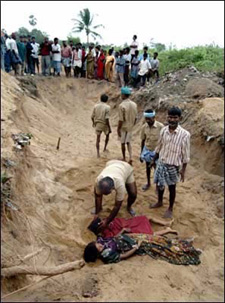The term tsunami from the Japanese and means "Big wave in the port".
Tsunamis arise from the sudden displacement of gigantic water masses due to earthquakes on the sea bed, Volcanic eruption above and under water, landslides or meteorite impacts. About 86 % of all Tsunamis result from so-called seaquakes.
In order for a tsunami caused by a seaquakes to occur, three things have to be happen:
1: The Earthquake must measure at least 7,0 on the Richter scale. Only from this intensity upwards is there enough energy released to rapidly displace enough water to create the tsunami.
2: The sea bed must be lifted or lowered by the earthquake. If the sea bed is displaced sidewards, no tsunami will occur as, for example, happened during the earthquake of 28 March, 2005 off the western coast of Sumatra.(Xcaye? u can google it )
3: The epicentre of the earthquake must be near to the earth's surface.
HOW DOES A TSUNAMI DEVELOPS???????
ok,let me explain here....
The difference between tsunamis and normal waves or waves caused by strong wind is the extreme distances between wavelengths.
This is the distance from one wave crest to the next wave crest, which can be between 100 and 300 km.
A further feature of tsunamis is their relatively small wave height on the open sea - mostly between half a metre and one meter. Even though they can travel up to 1 000 km/h, these waves are generally not noticeable in deep waters.
In coastal areas where water levels gradually become shallower, the wave will slow down but tower into a wave wall as much as 30 meters high.
The reason for this is the mass of water and energy contained in the tsunami wave. Whereas only the upper water layers are being moved in wind created waves, with a Tsunami wave, an entire mass of water from the sea bed to the surface is in motion.
If a trough of a tsunami wave approaches the land first, the water will be pulled back into the sea by enormous currents. (oh my GODDESS!!!I'm grateful to be a Malaysian )
Vast stretches of the seabed are often drained as happened during the December 2004 tsunami. In this case, and if recognised, people on the beach and beachfronts have between a few minutes and half an hour to escape to higher ground.
The time to escape depends on when the wave crest strikes.
The first wave, that can grow to be up to 30 meters high at the beach, will usually be followed by more waves that are sometimes even more dangerous.
Not only the crests of waves are dangerous but also the troughs, since their currents can pull people and whole houses many miles into the sea.
The Tsunami Alarm warning time can be between a few minutes up to several hours, depending on distance from the earthquake's epicentre.
many people dies of tsunamis ...
at Acheh
tsunami victims were buried in a massive grave







No comments:
Post a Comment